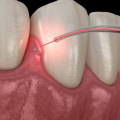Laser-assisted periodontal therapy (LAPT) is the latest breakthrough in eliminating periodontal infections. The WaterLase MD laser uses a specific wavelength that attacks and destroys diseased tissue and bacteria in the periodontal pockets, offering many benefits over traditional surgery. This non-invasive procedure requires only two 2-hour office visits and two follow-up visits, with little or no discomfort, tenderness, swelling, or bleeding. During recovery, it is important to carefully avoid chewing food in the area where the laser was used and to stay away from spicy foods and things like French fries, popcorn, and pretzels to avoid irritating the surgery site.
Do not use straws to avoid suction for the next few days. After the first 24 hours of healing are complete, brush and floss adjacent teeth normally and gently clean the area where the laser was used with a swab dipped in Listerine. The Waterlase iPlus laser treatment is as non-invasive as possible. The gum or bone is not cut like in traditional surgery. Using the LAPT, a small laser fiber is inserted into the cavity of the diseased gum.
This precise laser disintegrates bacteria and diseased tissue without damaging any healthy tissue. The disease is removed and healthy gums and bones have a good chance of regenerating. The body naturally wants to repair itself, as it eliminates diseased tissue and, at the same time, preserves healthy tissue and previously infected areas are sealed. Healthy tissue is then given a chance to grow back. In the last step of the procedure, the laser is applied once more to clean and sterilize the area.
The laser is then used to seal it with a blood clot. This prevents the infection from growing back and promotes an environment in which the gums and bone can regenerate. There are many cases of LAPT in which the patient's infected areas were dramatically reduced and bone growth stabilized the teeth. One of the unfortunate aspects of traditional periodontal surgery is that it is necessary to cut the gums to expose the lower part of the periodontal pockets where periodontal bacteria grow. This procedure can cause gum recession and expose roots, which can make teeth look unsightly.







